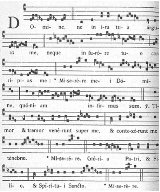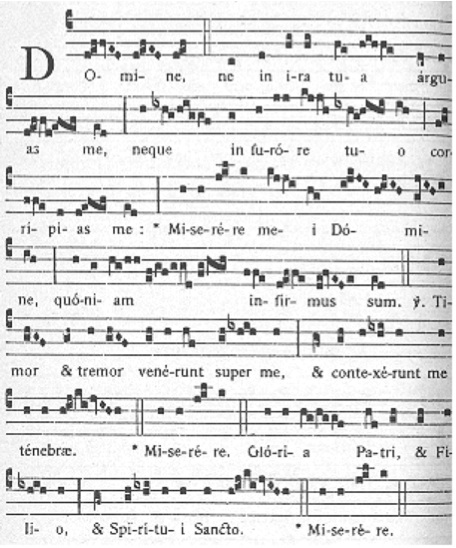
Responsory
Encyclopedia
Definition
The most general definition of a responsory is any psalm, canticle, or other sacred musical work sung responsorially, that is, with a cantor or small group singing verses while the whole choir or congregation respond with a refrain. However, this article focuses on those chants of the western Christian tradition that have traditionally been designated by the term responsory. In the Roman RiteRoman Rite
The Roman Rite is the liturgical rite used in the Diocese of Rome in the Catholic Church. It is by far the most widespread of the Latin liturgical rites used within the Western or Latin autonomous particular Church, the particular Church that itself is also called the Latin Rite, and that is one of...
and rites strongly influenced by it, such as the pre-reformation English rite and the monastic rite of the Rule of St. Benedict, these chants ordinarily follow readings at services of the Divine Office
Liturgy of the hours
The Liturgy of the Hours or Divine Office is the official set of daily prayers prescribed by the Catholic Church to be recited at the canonical hours by the clergy, religious orders, and laity. The Liturgy of the Hours consists primarily of psalms supplemented by hymns and readings...
(also called the Liturgy of the Hours
Liturgy of the hours
The Liturgy of the Hours or Divine Office is the official set of daily prayers prescribed by the Catholic Church to be recited at the canonical hours by the clergy, religious orders, and laity. The Liturgy of the Hours consists primarily of psalms supplemented by hymns and readings...
); however, they have also been used as processional chants.
Structure and performance

Doxology
A doxology is a short hymn of praises to God in various Christian worship services, often added to the end of canticles, psalms, and hymns...
, Gloria Patri et Filio et Spiritui Sancto, sung by the cantor, followed in turn by a third repetition of all or part of the respond.
As an example, here is the responsory Aspiciebam, which in the Sarum Rite
Sarum Rite
The Sarum Rite was a variant of the Roman Rite widely used for the ordering of Christian public worship, including the Mass and the Divine Office...
(the medieval rite of Salisbury Cathedral
Salisbury Cathedral
Salisbury Cathedral, formally known as the Cathedral Church of the Blessed Virgin Mary, is an Anglican cathedral in Salisbury, England, considered one of the leading examples of Early English architecture....
in England
England
England is a country that is part of the United Kingdom. It shares land borders with Scotland to the north and Wales to the west; the Irish Sea is to the north west, the Celtic Sea to the south west, with the North Sea to the east and the English Channel to the south separating it from continental...
) followed the second reading, which was from the first chapter of the Book of Isaiah
Book of Isaiah
The Book of Isaiah is the first of the Latter Prophets in the Hebrew Bible, preceding the books of Ezekiel, Jeremiah and the Book of the Twelve...
, at the night office (Matins
Matins
Matins is the early morning or night prayer service in the Roman Catholic, Anglican, Lutheran and Eastern Orthodox liturgies of the canonical hours. The term is also used in some Protestant denominations to describe morning services.The name "Matins" originally referred to the morning office also...
) on the first Sunday of Advent
Advent
Advent is a season observed in many Western Christian churches, a time of expectant waiting and preparation for the celebration of the Nativity of Jesus at Christmas. It is the beginning of the Western liturgical year and commences on Advent Sunday, called Levavi...
:
Respond: (started by the cantor and continued by the whole choir) Aspiciebam in visu noctis, et ecce in nubibus caeli Filius hominis veniebat: et datum est ei regnum, et honor: * Et omnis populus, tribus, et linguae servient ei. (I saw in a night-vision, and behold, the Son of Man was coming on the clouds of heaven: and sovereignty and honor were given him: and every people and tribe, and all languages shall serve him.)
Verse: (sung by the cantor) Potestas eius, potestas aeterna, quae non auferetur: et regnum eius, quod non corrumpetur. (His might is an everlasting might which will not be taken away; and his reign is an everlasting reign, which shall not be broken.)
Partial respond: (sung by the choir) Et omnis populus, tribus, et linguae servient ei. (And every people and tribe, and all languages shall serve him.)
Most responsories have a single verse, but a few have multiple verses. One of the most famous of the latter is the responsory Aspiciens a longe, sung on the first Sunday of Advent after the first reading in the night office of the Latin secular (non-monastic) rite. The version that was sung in the medieval rite of Salisbury cathedral was worded as follows:
Respond: Aspiciens a longe et ecce video Dei potentiam venientem et nebulam totam terram tegentem. Ite obviam ei et dicite, Nuntia nobis si tu es ipse qui regnaturus es in populo Israel. (I look from afar, and behold I see the power of God coming, and a cloud covering the whole earth. Go out to meet him and say, tell us if you are the one who is to reign over the people of Israel.)
1st verse (sung by a boy) Quique terrigenae et filii hominum simul in unum dives et pauper (Whoever are earth-born, the sons of men, together in one rich and poor)
Partial respond (sung by the choir) Ite obviam ei et dicite, Nuntia nobis si tu es ipse qui regnaturus es in populo Israel. (Go out to meet him and say, tell us if you are the one who is to reign over the people of Israel.)
2nd verse (sung by a boy) Qui regis Israel intende, qui deducis velut ovem Joseph (Hear, O shepherd of Israel, who leadest Joseph like a sheep)
Partial respond (sung by the choir) Nuntia nobis si tu es ipse qui regnaturus es in populo Israel. (Tell us if you are the one who is to reign over the people of Israel.)
3rd verse (sung by a boy) Excita Domine potentiam tuam et veni ut salvos facias nos (Stir up your power O Lord and come that you may save us)
Parital respond (sung by the choir) Qui regnaturus es in populo Israel. (O you who are to reign over the people of Israel.)
Half-doxology (sung by all three boys) Gloria Patri et Filio et Spiritui Sancto (Glory be to the Father and to the Son and to the Holy Ghost)
Partial respond (sung by the choir) In populo Israel. (In the people of Israel.)
The three boys then sang Aspiciens a longe whereupon the choir took up the full respond: et ecce video Dei potentian venientem et nebulam totam terram tegentem. Ite obviam ei et dicite, Nuntia nobis si tu es ipse qui regnaturus es in populo Israel. (I look from afar, and behold I see the power of God coming, and a cloud covering the whole earth. Go out to meet him and say, tell us if you are the one who is to reign over the people of Israel.)
This responsory, Aspiciens a longe, has become familiar in the English-speaking world in an arrangement published in the second volume of Carols for Choirs
Carols for Choirs
Carols for Choirs, published by Oxford University Press, edited by Sir David Willcocks with Reginald Jacques and John Rutter, is the most widely-used source of carols in the British Anglican tradition, and among British choral societies.There are four books in the original series and a portmanteau...
edited by David Willcocks and John Rutter
John Rutter
John Milford Rutter CBE is a British composer, conductor, editor, arranger and record producer, mainly of choral music.-Biography:Born in London, Rutter was educated at Highgate School, where a fellow pupil was John Tavener. He read music at Clare College, Cambridge, where he was a member of the...
, where it is given the title "Matin Responsory", and is set to music adapted from a setting by Giovanni Pierluigi da Palestrina
Giovanni Pierluigi da Palestrina
Giovanni Pierluigi da Palestrina was an Italian Renaissance composer of sacred music and the best-known 16th-century representative of the Roman School of musical composition...
of the Nunc dimittis
Nunc dimittis
The Nunc dimittis is a canticle from a text in the second chapter of Luke named after its first words in Latin, meaning 'Now dismiss...'....
(free score of the Nunc dimittis here on CPDL
Choral Public Domain Library
The Choral Public Domain Library is a sheet music archive which focuses on choral and vocal music in the public domain or otherwise freely available for printing and performing .-Description:...
) - and not of the Magnificat
Magnificat
The Magnificat — also known as the Song of Mary or the Canticle of Mary — is a canticle frequently sung liturgically in Christian church services. It is one of the eight most ancient Christian hymns and perhaps the earliest Marian hymn...
as stated by the editors. The structure of the Willcocks/Rutter arrangement, however, differs somewhat from what is shown above since it does not repeat the refrain after each verse in the traditional English way. For example, in the traditional English form (shown above) after the first verse, the choir sings all the words of the refrain from ite obviam ei to the end. In the Willcocks/Rutter arrangement, on the other hand, after the first verse the choir sings (in English translation) only the portion of the refrain corresponding to the Latin words ite obviam ei et dicite.
Music
Traditionally responsories are sung in Gregorian chantGregorian chant
Gregorian chant is the central tradition of Western plainchant, a form of monophonic liturgical music within Western Christianity that accompanied the celebration of Mass and other ritual services...
. The refrains are free compositions. The verses are ordinarily sung to standard tones, though there are exceptions to this. Polyphonic settings of parts of responsories survive from the Middle Ages. The example of the Willcocks/Rutter setting of Aspiciens a longe shows that multi-voice settings of responsories have continued to be made in modern times also.

